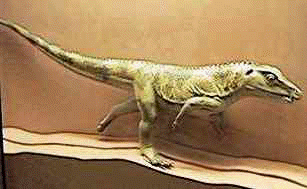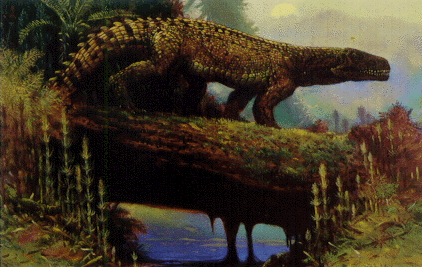Archosauria: The Thecodonts

The classic (mid 20th century) image of the "pseudosuchian" thecodont, a small, bipedal reptile (Ornithosuchus). Up until the 1970s, animals like this were considered to be ancestral to both birds and (separately) dinosaurs. This model would seem to be based on a juvenile. More recent reconstructions present Ornithosuchus as a much larger (over 3 meters), carnosaur-like animal (see for example Walker 1964). This photo is of a model from the Elgin Museum |
The "Thecodonts" - Masters of the Triassic
During the Triassic period, at the start of the Mesozoic era, there lived a whole lot of animals that were no longer small and insignificant lizard-like forms, but not actually crocs, dinosaurs, pterosaurs, or birds. These are the "thecodonts".
Thecodonts are defined by certain shared primitive or ancestral features, such as the suborbital fenestra (an opening on each side of the skull between the eye sockets and the nostrils) and teeth in sockets. The name Thecodont is actually Latin for "socket-tooth," referring to the fact that thecodont teeth were set in sockets in the jawbones; an archosaurian characteristic that was inherited by the dinosaurs.
From an evolutionary systematic point of view, the Thecodonts are a valid taxon of Triassic archosaurs. They include both the ancestors of dinosaurs and other animals, and a number of independent evolutionary lines that are important in their own right. And they dominated the Triassic. For as long as they were there, no crocodile or armored herbivorous or general carnivorous dinosaur could grow very big. It was only one of the accidents in the history of life on Earth, an impact by a wandering asteroid or comet, that wiped the thecodonts from the land and provided their successors, the dinos and crocs, to take their place
From the cladistic point of view, Thecodontia is a paraphyletic group, like cotylosaurs, the pelycosaurs, condylarths, and for that matter the colloquial as opposed to the cladistic definition of dinosaurs. Because they represent a "grab-bag" taxon for any archosaur that wasn't a crocodilian, a pterosaur, or a dinosaur, the term is considered to have no phylogenetic value.
The term Thecodontia is rarely used in current literature, but appears in evolutionary systematic-based books published pre-1990 or so, and in various on-line taxonomic lists based on them. The most recent version is Olshevsky (1991)'s "Superorder Thecodontia", which we have updated to Paraorder Thecodontia (the use of the para- suffix to indicate paraphyletic linnaean taxon was suggested by Olshevsky but did not catch on, prior to our adopting it).
In this context, "thecodont" remains a useful term as shorthand for "basal archosaur" and we will use it in that sense here. In fact, the term "thecodont" is more limited and usually refers to the basal archosauriforms. These are reptiles in which the ankle has been somewhat simplified and reorganized to permit the more erect carriage mentioned above. Although very similar anatomically and clearly related to each other by common ancestry and many shared ancestral traits (plesiomorphies), the thecodonts are no longer considered a single taxon, but rather are divided along cladistic (phylogenetic) lines. (MAK)
Content MAK 991003 & 030730, updated MAK101007, last revised MAK120313
Using this material. All material by ATW is public domain and may be freely used in any way (also any material jointly written by ATW and MAK). All material by MAK is licensed Creative Commons Attribution License Version 3.0, and may be freely used provided acknowedgement is given. All Wikipedia material is either Gnu Open Source or Creative Commons (see original Wikipedia page for details). Other graphics are copyright their respective owners

